Top News
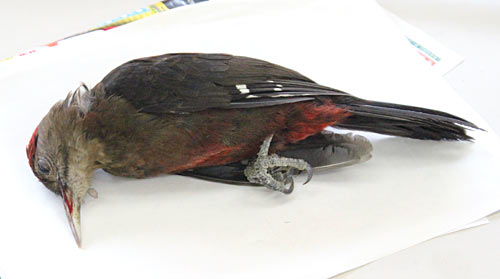
October 29, 2014 Ryukyu Shimpo
On October 28, at Takae Elementary and Junior High School in Higashi, a dead Okinawa woodpecker or Noguchigera designated as a special national treasure was found. This bird presumably bumped into a window and died. Four dead Okinawa woodpeckers, including this bird, were found within and near the school this year.
According to Tamotsu Nakamura, a noguchigera bird protection warden of Higashi-son who is familiar with the Okinawa woodpecker’s livelihood, there are very few cases where Okinawa woodpeckers have hit window glass and died. He said, “There is no record of four birds dying in a year. This is an unusual situation.” He speculates that major changes are taking place in the Okinawa woodpecker’s habitat. “Low-altitude flights of the U.S. military aircraft, including MV-22 Ospreys, presumably affected the habitat of the birds,” he said.
In February, a dead Okinawa woodpecker was found at a house near the school. On August 5 and 13, two dead woodpeckers were found in the school. All the woodpeckers possibly died in collisions with the windows of the house or classrooms. The school has put photographs of raptors on the windows of classrooms in order to scare away the birds, which could face risk of extinction. Despite such measures, the bird collision on the window took place on October 28. The dead Okinawa woodpecker is a 30.5 cm long male adult.
Chousei Tamaki, a leader of an environmental NGO that is researching wild animals such as noguchigera, said, “It’s unusual. In the season when it is becoming cold, Okinawa woodpeckers live in the back of the valley and forest. Something took place in the back of the forest to disrupt the bird’s living environment. There is also the possibility of influence from the helipad construction.”
Noguchigera bird protection warden Nakamura has researched Okinawa woodpeckers for about 40 years while working at the Higashi municipal office. He stressed, “The Okinawa woodpecker is a special national treasure. We should think about this issue more seriously because this is critical not only to Okinawa but also to the country.”
(English translation by T&CT)
An Okinawa wood pecker that presumably hit a window and died at Takae Elementary and Junior High School in Higashi on October 28.
Go to Japanese
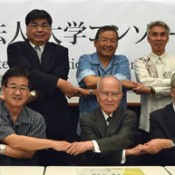
October 25, 2014 Ryukyu Shimpo
Eleven higher education institutions in Okinawa, including public and private colleges and universities, the Okinawa National College of Technology, and the Okinawa Institute of Science and Technology (OIST) established a coalition organization “University Consortium Okinawa.” On October 24 at OIST in Onna Village, university presidents held a press conference. The consortium aims to do collaborative research, create a credit transfer system, and external courses for working people. It aims to contribute to regional vitalization through global human resource development and cooperation among government, industry and academia. On December 23, the consortium will hold an inaugural symposium.
Former president of Meio University Eiki Senaha, who took up a post as an executive board member, announced at the press conference, “The consortium makes it possible for universities to work collaboratively. The establishment is historically significant. I hope Okinawan residents look forward to what the collaboration of universities could offer.” The consortium also plans to make it possible to open mutual access to research facilities among universities.
This year, they will create the first external courses to start in January 2015 and hold a student summit. Adult education classes will take the form of consecutive classes and a certificate of completion will be issued. The credit transfer system, which acknowledges credits from other universities, will begin as early as the academic year of 2015.
Due to late administrative procedures, the Prefectural University of Arts and the Prefectural College of Nursing will take part in the consortium as observers this year. The consortium also calls for participation from the business community.
(English translation by T&CT and Megumi Chibana)
Go to Japanese
October 25, 2014 Ryukyu Shimpo
The Ryukyuan Heritage Language Society held the 18th Foundation of Endangered Languages Symposium this September. On October 24, the society wrote up a declaration for the symposium. The organization suggested that Okinawa should adopt Ryukyuan languages or Shimakutuba as second language and include classes for the languages in education programs at schools. A representative of the society handed over the statement to the Okinawa Prefectural Government and Prefectural Assembly on October 24. The organization plans to send the statement to the Agency for Cultural Affairs and Kagoshima Prefectural Government to which Amami belongs but is also part of the Ryukyu language region. Shinsho Miyara chair of the society said, “It is important to provide an environment where Okinawan people can choose to study languages inherited in the prefecture and learn them.”
(English translation by T&CT)
Go to Japanese

October 31, 2014 Ryukyu Shimpo
The 12th Okinawa gubernatorial election started on October 30. Four candidates, including former State Minister in Charge of Postal Services Privatization Mikio Shimoji, 53, former Upper House member Shokichi Kina, 66, former Naha Mayor Takeshi Onaga, 64, and incumbent Governor Hirokazu Nakaima, 75, are running. All of them have announced their candidacies as independent.
Their policies are clearly different on the U.S. Marine Corps Air Station Futenma relocation issue, which is the major issue of the election.
The Okinawan people’s decision on the new governor will significantly influence the plan to relocate the Futenma base to Henoko, Nago, where a new replacement offshore U.S. air base would be built. A fierce race is expected.
Ballot-casting will start on November 16, and the votes will be counted on the same day.
On the morning of October 30, each of the candidates started their campaigns after filing their candidacies.
As well as differing on the Henoko relocation, they also have different policies regarding the approval of casinos in Okinawa. The candidates will actively debate over policies of economic promotion, education, child-support, and public welfare.
The centrist parties, including the Liberal Democratic Party (LDP) and the Komei Party have ruled Okinawa for four terms over 16 years. However, the conservatives have split this time. The ruling party’s partner, the Komei Party, has decided to allow their supporters to vote voluntarily. This election will not be fought along the old battle lines of conservative versus liberal.
While Shimoji suggested holding prefecture-wide referendum to let voters decide the outcome of the relocation issue, Kina says he aims to rescind and cancel Nakaima’s approval of the Henoko landfill. Onaga strongly opposes the plan and will ask the U.S. and Japanese governments to move the base outside Okinawa and Japan. Nakaima claims he will stop the operation of Futenma Air Station within five years. He supports the plan to move it to Henoko.
Although the Japanese government has said that it intends to push the plan regardless of the election result, Okinawan people’s decision on the new governor could influence the progress of the relocation.
At his campaign launch party, held in the Izumizaki district of Naha, Shimoji said, “I would like Okinawan people to decide whether they want the base to remain in the area, and the central government should follow their decision. If the people oppose the plan, I will suggest an alternative plan. If they approve the relocation, the central government can fairly and squarely carry out the construction work.”
At his departing ceremony in Kudaka Island of Nanjo City, Kina said, “I declare that I will cancel Nakaima’s approval of the Henoko landfill. People do not need U.S.military bases in Okinawa or anywhere in the world either.”
In his campaign-opening speech, in the Tsubogawa district of Naha, Onaga said, “Futenma Air Station should be moved outside of Japan or Okinawa. I will do everything I can to prevent the new base construction.”
At his election-campaign party, held in the Makishi district of Naha, Nakaima said; “We need to relocate Futenma Air Station, which is the most dangerous in the world, to Henoko. I will do my best to stop the operation of the base within five years, which Prime Minister Shinzo Abe promised.”
Shimoji:hold a prefecture-wide referendum to let voters decide the relocation issue
I would like to end the relocation issue by holding a prefecture-wide referendum.
We are in political turmoil. Although the LDP lawmakers elected from Okinawa pledged to move the base outside Okinawa, they changed their minds and pushed for relocating it within the prefecture.
We cannot solve the issue by electing politicians based on whether they favor or oppose the plan. Okinawan people should play the leading part and decide on the issue. Abe should follow that decision. I have a big dream. I will build a railroad in Okinawa within 10 years.
By constructing Universal Studios and ball game theme parks, I would like to energize Okinawa.
I will make educational expenses free to end child poverty in Okinawa. If I win the election, I will be the first Okinawa Governor in their 50s. I will change the history of Okinawa. I will become an outstanding governor nationwide.
Mikio Shimoji was born in Miyakojima City on August 14, 1961. Shimoji graduated from Chuo Gakuin University. Belonging to the LDP, he became a Lower House member in 1996. Shimoji turned became an independent in 2005, and belonged to the People’s New Party in 2009. He became a Lower House member four times. Shimoji took up a post as executive head of the party in 2010. After serving as State Minister in Charge of Postal Services Privatization and Minister of State for Disaster Management in 2012, he lost an election.
Kina: cancel Nakaima’s approval of the Henoko landfill
I declare that I will cancel the governor’s approval of the landfill. I will do everything I can to cancel the approval. There are currently many wars all around the world. I will bring the heart of Okinawa to the world and make the flower of peace bloom. If mountains and seas are vibrant, we can live life. Although there are ongoing desertization of land, destruction of tropical rainforests and anathermal, we could launch the energy and science revolution from Okinawa. Being rich does not make stable economy. I will set up guaranteed minimum income system in remote islands of Okinawa for the first time in Japan to establish a lifestyle, in which people can live off the earth on islands.
Shokichi Kina was born in Okinawa City on June 10, 1948. He left Okinawa International University without a diploma. Kina became a musician. Belonging to the Democratic Party of Japan (DPJ), he was elected as an Upper House member under proportional representation in 2004. In the same year, Kina took up a post as a representative of the Okinawa branch of the DPJ. He lost an election in 2010. Kina resigned as representative of the Okinawa branch of the DPJ in October 2014. The DPJ expelled him from the party because of his running for the governor.
Onaga: never allow the construction of the new base to happen
This morning, I joined my hands in prayer in front of Tower of Souls in Mabuni, Itoman. I am mortified that many people died in the Battle of Okinawa. I thought from my heart, the origin of politics should derive from peace. Although I am a conservative, I am an Okinawan conservative. I express understanding for the Japan-U.S. Security Arrangements. However, I will never tolerate the unreasonableness of focusing 74 percent of the U.S. military facilities in Japan on Okinawa that makes up less than 0.5 percent of the nation’s territory.
I will do everything I can to prevent the new base from being built in Henoko. Some of the lawmakers reneged on their pledges to move the base outside Okinawa. However, Okinawan people have not changed. Through this election, Okinawan people express their opposition against the construction of the new base. We would like to make our children and grandchildren proud of Okinawa, which has a hopeful future that will launch into Asia and the world. We will accomplish this goal.
Takeshi Onaga was born in Naha on October 2 1950. He graduated from Hosei University. After working as a company employee, Onaga became a member of the Naha City Assembly with the LDP in 1985. After serving for two terms, he became a member of the Okinawa Prefectural Assembly in 1992. After serving for two terms at the Okinawa Prefectural Assembly, Onaga took up a post as the executive head of the Okinawa branch of the LDP. He became Naha Mayor as independent and served for four terms over 14 years. Onaga left his office this year.
Nakaima: priority is to solve Futenma Air Base problems
With pride as an Okinawan, I will devote the rest of my energy to solving the problems caused by Futenma Air Base. That’s the priority. I approved the Henoko landfill at the end of the last year. Abe assured us that the Japanese government would stop the operation of the base within five years. Although it was a painful choice, people in the Henoko district support my decision with conditions.
By making the area occupied by the base smaller and moving it one kilometer away from the residential districts, we will make the base safer. I would like Okinawan people to reach out to Ginowan residents and help each other. The Okinawan economy is becoming independent. Please give me another four years so that I can protect your lives. I am pretty sure that I can bring results.
Hirokazu Nakaima was born in Naha on August 19 1939. He graduated from the University of Tokyo. Nakaima started working at the Ministry of Economy, Trade and Industry from 1961. In 1990, he became vice governor and worked for then governor Masahide Ota. Nakaima was consecutively the president of the Okinawa Electric Power Company and the president of the Joint Association of Chamber of Commerce of Okinawa. He became Okinawa Governor in 2006. This is his second term.
(English translation by T&CT)
Go to Japanese
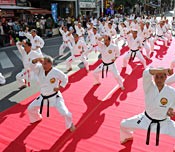
October 27, 2014 Ryukyu Shimpo
Commemorating Karate Day, the Okinawa Prefectural Government, the Prefectural Assembly and the Okinawa Dento Karatedo Shinkokai held a martial arts demonstration on October 26 at a plaza near Kokusai Street, Naha. About 1000 martial artists from four organizations, including the Okinawa Prefecture Karate Do Renmei, Zen Okinawa Karate Do Renmei and Okinawa Karate Kobudo Renmei, under the Okinawa Dento Karatedo Shinkokai, took part in the event.
In part one of the event, masters representing their styles of karate performed their routines. Spectators watched with amazement, the moves performed by the masters.
In part two, karate lovers of all generations, including seniors and preschool children, demonstrated their styles at four areas on Kokusai Street, making it a paradise for pedestrians that day.
Choukou Kiyuna, the chairman of the Okinawa Dento Karatedo Shinkokai, said, “We would like to register Okinawa Karate on UNESCO’s Intangible Cultural Heritage list. This will let the people of the world know that Okinawa is the birth place of karate.”
(English translation by T&CT)
Go to Japanese

October 22, 2014 Yukito Kinjo, correspondent of Ryukyu Shimpo
On October 18, Matsuo Tamaki and Koki Kinjo caught a 1.65-meter and 16-kilogram giant moray near Ie Island. They were surprised to see it when they pulled it out of water. On that day, they were aiming to catch red-spotted rockcod, but while landing the fish, they felt a different tug on the rod to what they were used to. A moray, called “gang in the sea” ran wildly on the ground showing its sharp teeth.
The moray was about the same height as Tamaki and Kinjo. Tamaki had caught a giant moray three times before. He said, “This moray catch is my best record. Next time, I want to catch a moray twice as big as the one we caught this time.” They cooked and ate deep-fried moray and miso moray stew.
(English translation by T&CT, Hitomi Shinzato)
Go to Japanese
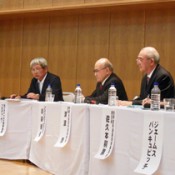
October 26, 2014 Ryukyu Shimpo
October 25 is designated as “Karate Day” by the Okinawa Prefectural Government (OPG). The OPG, Prefectural Assembly and the Okinawa Dento Karatedo Shinkokai held a symposium in Naha City for the occasion. About 170 people took part in the symposium. The participants, including karate men and women from within and outside of Okinawa, explored the challenges of adding Okinawa Karate to UNESCO’s Intangible Cultural Heritage list.
Former TV producer Kiyoshi Ono, who made a work titled The World Heritage Relaxing in TBS program, gave the keynote speech. He highlighted the significance of UNESCO’s intangible cultural heritage. Ono said, “In the course of the campaigns for intangible cultural heritage, it is important that both the people involving in karate and ordinary citizens recognize the value of karate.”
Board members of the Okinawa Dento Karatedo Shinkokai and the World Karate Federation, and a karate practitioner from the United Kingdom took part in the panel discussion. They discussed the future prospects of Okinawan karate.
Zenpo Shimabukuro, who chaired Karate Day’s event, said, “Beginners can progress in Karate in a short period of time. You, both young and old, can practice anywhere and anytime. It’s the charm of this sport. I am happy that I have been doing karate because it has provided spiritual support for me.”
Choukou Kiyuna, the chairman of the Shinkokai said in his speech, “We, members of traditional karate and sports karate organizations, will take our hands together to carry out the campaign goal to add Okinawa karate to the list of intangible cultural heritage.”
(English translation by T&CT)
Go to Japanese
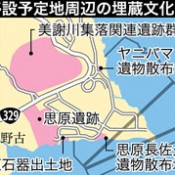
October 24, 2014 Ryukyu Shimpo
The Okinawa Prefectural Board of Education has recommended that the Okinawa Defense Bureau consult the Nago City Board of Education with regards to the conduct of the preliminary investigation and handling of five pieces of cultural artefacts found inside Camp Schwab, in the area where the Futenma Air Station is planned for relocation. It did so by a deadline of October 23.
The Okinawa Defense Bureau had notified Nago City about the commencement of construction works in April 2015. However, the Nago City Board of Education had presented a view that “cultural artefacts must be preserved.” The Prefectural Board of Education determined that no agreement was reached. The buried artefacts were discovered in an onshore operations yard, where temporary passages will be constructed and sand will be obtained for reclamation. There is a possibility that plans for the construction of the replacement airbase may be delayed if there are difficulties with preliminary investigations such as experimental drilling and consultation with the city education board.
It is rare for the prefectural board of education to urge a developer to consult with a local body.
The prefectural board of education’s Cultural Properties Division delivered its recommendation for the Okinawa Defense Bureau through the city board of education on October 17. Typically, a recommendation document recommends one method from the following three methods: (1) Excavation (with records kept); (2) Attendance (at construction); (3) Careful and deliberate construction work. However, because no agreement has been reached between the Defense Bureau and the Nago City Board of Education, no method was specified.
The Prefectural Board of Education judged that “preliminary investigations were insufficient,” recommending that both sides understand clearly the details of the buried artefacts, such as the area in which they are located, after consulting with each other.
Preliminary investigations are normally conducted by municipal boards of education as they are more familiar with local cultural properties. The Defense Bureau can only end negotiations after hearing the Nago City’s views. However, Nago City holds the view that there is not enough time for a thorough investigation before the proposed start of construction in April 2015 because (1) the current preliminary investigations and cooperation are insufficient; and (2) a lengthy period of time is required because of the large area in which investigations must be carried out. If both parties find difficulties cooperating, in addition to delays to the plan for relocation, there is the possibility there might be pressure to re-evaluate the details of the construction work.
(English translation by T&CT and Lima Tokumori)
Go to Japanese

October 26, 2014 Ryukyu Shimpo
The sixth Kitanakagusuku Welfare Festival was held at Kitanakagusuku Village Comprehensive Social Welfare Center on October 25. Out of 600 applicants, 80-year-old Asae Mekaru, 87-year-old Tomiko Higa and 83-year-old Natsuko Yonamine won the fifth Beauty and Longevity Award. The village set up the award to promote the health and longevity of the community.
The village mayor Kunio Arakaki presented the certificates to them. Three women will fill their predecessors’ shoes. For a year, they will take part in village events as tourism ambassadors to promote tourist spots and the longevity of village residents.
According to the life-table analyses by municipalities of Japan in 2010, the average life expectancy of women in Kitanakagusuku is 89.0 years, ranking first in the nation.
The village started the contest four years ago in order to promote the longevity of its residents. Women over 80-years-old who are healthy and lively, are eligible for the contest. Mekari said, “We would like to work on promoting happy and healthy living.”
(English translation by T&CT)
Go to Japanese
October 27, 2014 Kyoko Ishii of Ryukyu Shimpo
Out of 61 barrels unearthed at a soccer ground on land returned by the U.S. military in Okinawa City, 18 of them contained fouling material with a concentration of 2,3,7,8-Tetrachlorodibenzodioxin (TCDD) at 50 percent. This level of toxicity in TCDD is considered the most dangerous dioxin for human health out of the eight chemical defoliants used by U.S. military forces during the Vietnam War. The dioxin, which contains a carcinogen, is part of other powerful defoliants used in the herbicidal warfare program during the Vietnam War such as Agent Pink and Green. These defoliants are more toxic than Agent Orange.
Hideaki Miyata, emeritus professor at Setsunan University who is regarded as a leading expert in dioxins, analyzed the results taken from the fouling material inside the barrels unearthed from Okinawa City as part of a research project carried out by the Citizens’ Network for Biodiversity in Okinawa. The research has scientifically proven the negative fallout of the Vietnam War remains in Okinawa.
TCDD was formed unintentionally as a side product in creating 2, 4, 5-Trichlorophenoxyacetic acid (2, 4, 5-T), a chlorophenoxy acetic acid herbicide. The dioxin was detected because the barrels were contaminated with 2, 4, 5-T. The decomposing materials of the herbicide and 2, 4, 5-T were detected in high concentration, in the fouling material of all the 18 barrels. 2, 4, 5-T was used to create Agent Pink and Green.
Miyata’s analysis ruled out the existence of six defoliants including Agent Orange. The Okinawa Defense Bureau claimed there was no evidence of defoliants. Miyata stressed, “Dioxins in soil will stay for a long time. The removal measure should be taken once the contamination has been confirmed.”
The U.S. and Japanese governments have denied the U.S. military brought defoliants to Okinawa. However, U.S. veterans testified that the chemical was stored, sprayed and dumped in Okinawa. The Okinawa Defense Bureau detected dioxin at a level 8.4 times the Environmental Quality Standard set by the Japanese government and other harmful ingredients inside the barrels found at the soccer ground.
Glossary: Agent Orange
The U.S. military used Agent Orange or Herbicide Orange (HO), a herbicide and defoliant, as part of its herbicidal warfare program during the Vietnam War from 1961 to 1971. The U.S.military dispersed Agent Orange and other defoliant formulations to destroy crops, bushes, trees, and vegetation in order to expose the Viet Cong, which used the cover of the jungle and farms for guerrilla warfare. The military also dispersed the defoliants to farming villages. The defoliant was given its name from the color of the orange-striped barrels in which it was shipped. As well as Agent Orange, which was used in the largest quantity, the U.S. military used powerful
herbicide-defoliants such as Agents Pink, Green, White, and Blue in its herbicidal warfare program. The toxicity of the dioxins brought serious health problems to the local people.
(English translation by T&CT)
Go to Japanese
October 21, 2014 Ryukyu Shimpo
During flight training on October 14, an F-15 fighter jet belonging to U.S. Air Force Kadena Base lost one of the engine parts, weighing 399 grams and 12.7 cm x 30.48 cm in diameter . According to the Okinawa Prefectural Government (OPG), it is not yet known from which part of the aircraft the part came off. There have been no reports of damage such as injuries. It is the fourth incident of its kind, in which F-15 parts or components fall off, this year.
The Governments of Japan and the United States agreed in 1997 that the U.S. would notify Japan immediately if parts fall from a U.S. military aircraft, whether inside or outside the bases. However, the OPG and local municipality offices received the incident information on October18, four days after the incident took place. According to the OPG, the missing part is a convergent engine liner. Incident information usually includes date, location, and a description of the incident. The base officials reported only that the accident took place in the airspace southwest of the base. However, the exact time the incident occurred is unknown.
Kadena Town Mayor Hiroshi Toyama, the president of the three municipalities liaison council consisting of the mayors of Okinawa City, Kadena and Chatan Town near the Kadena Air Base, criticized the U.S. military, saying that “The incidents of parts falling from U.S. aircraft have taken place one after another. The U.S. military is not taking measures to prevent recurrence of such incidents. They should stop F-15 flights and carry out safety inspections for all the aircraft. If they do not provide a solution, we cannot accept F-15 flight training.”
Wataro Rai, a member of a volunteer citizen group Rim Peace, which monitors the U.S. forces in Japan, said, “There is a possibility that the part falling from the aircraft might trigger the engine to stop or explode. If the part hit a pedestrian, it would have been a catastrophe. I speculate that the aircraft are ageing and the maintenance is not up to the standards of flight operation.”
(English translation by T&CT)
Go to Japanese








 Webcam(Kokusai Street)
Webcam(Kokusai Street)


